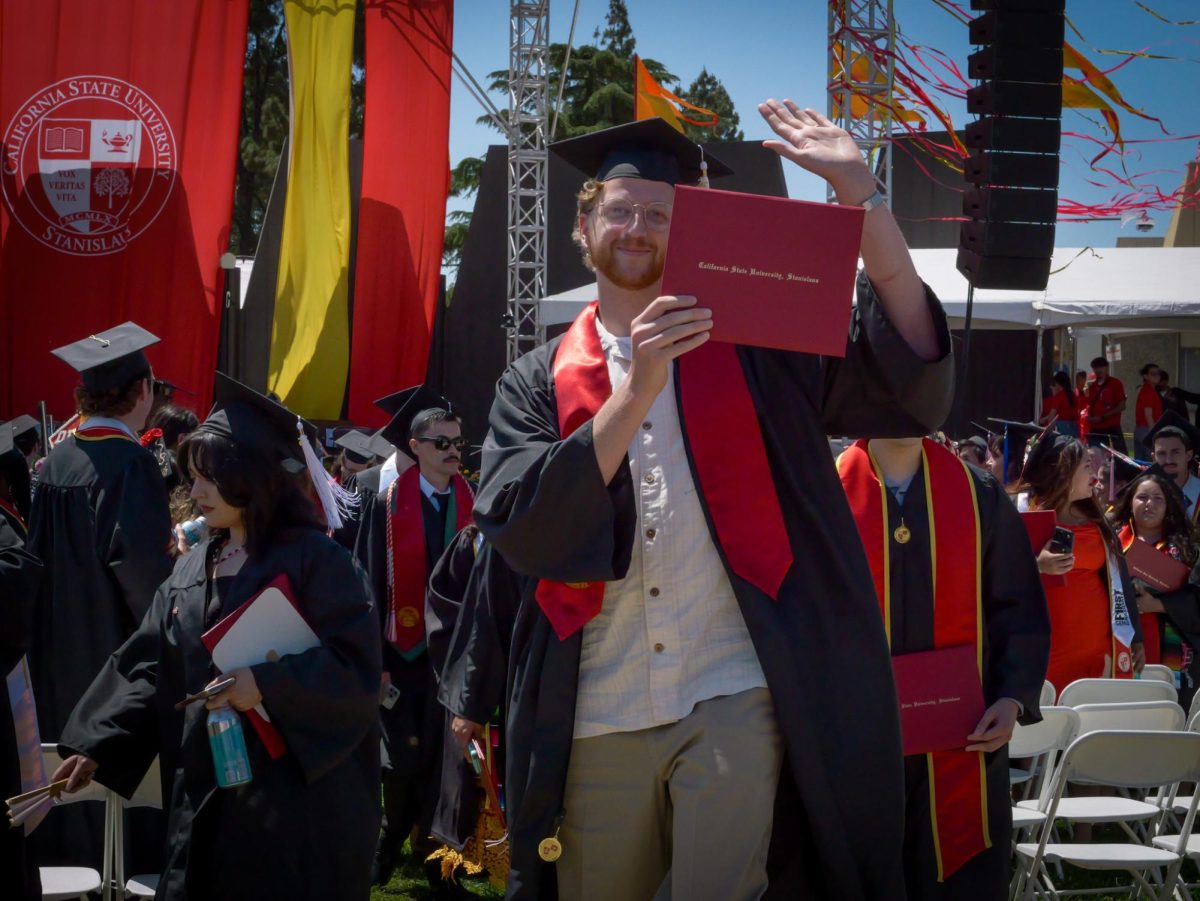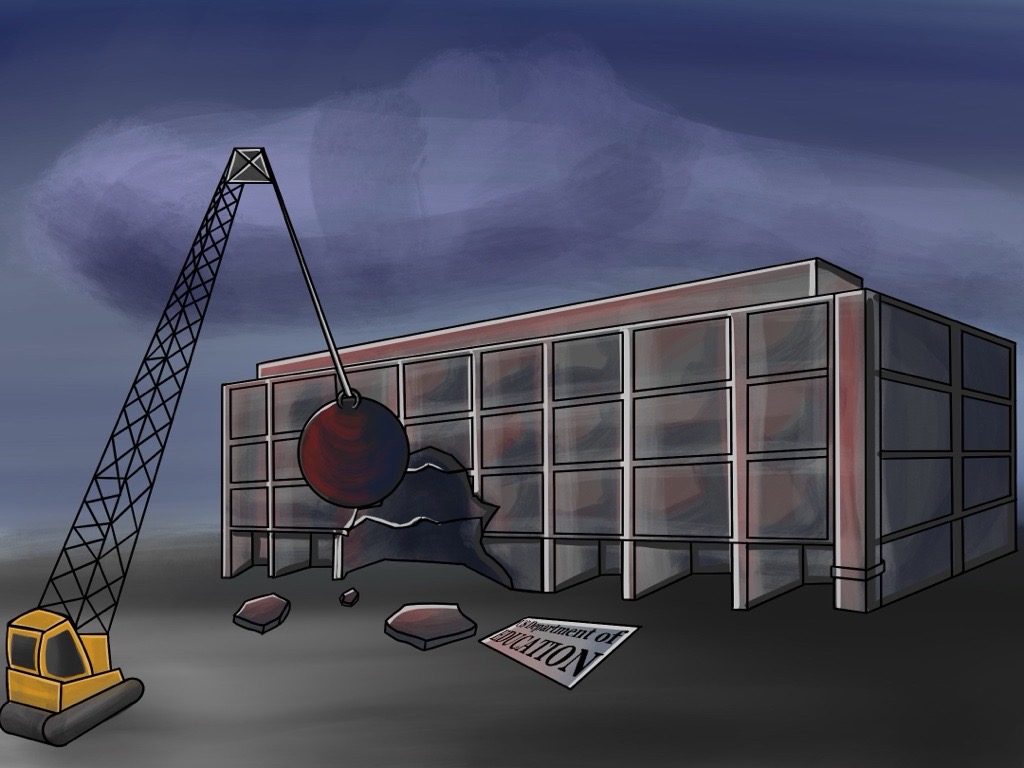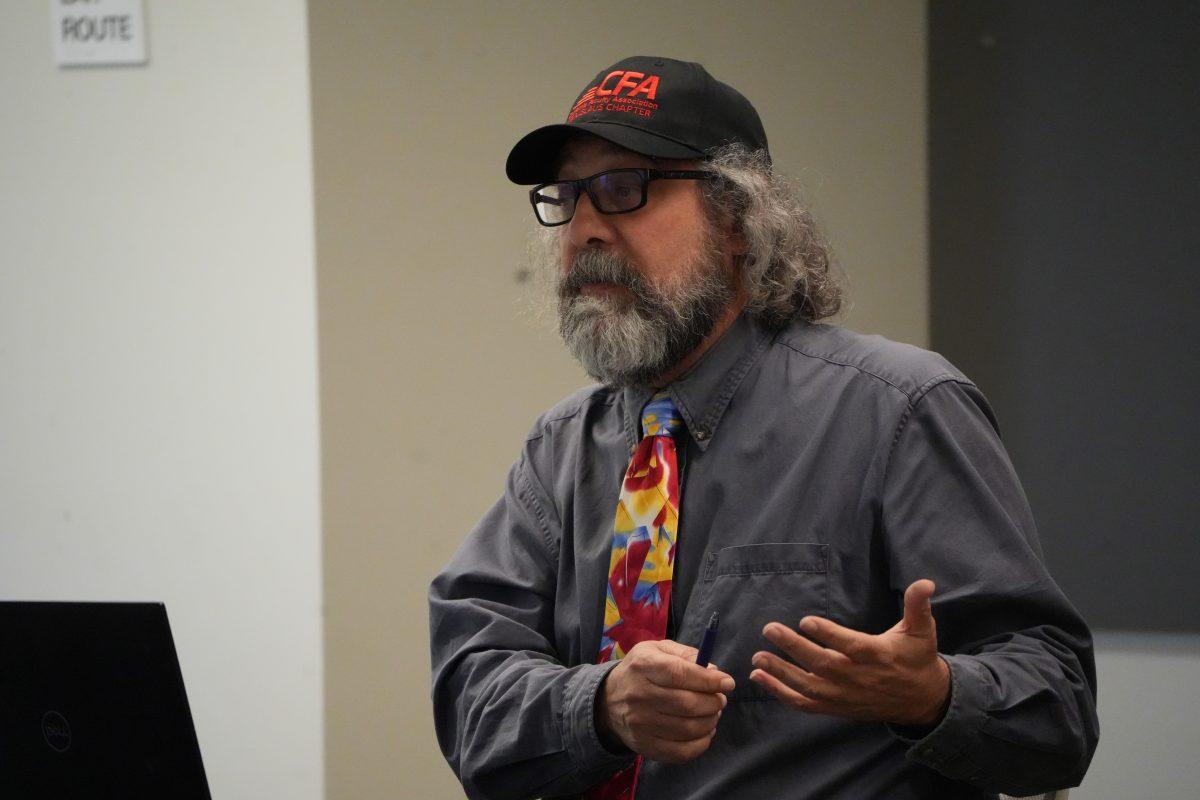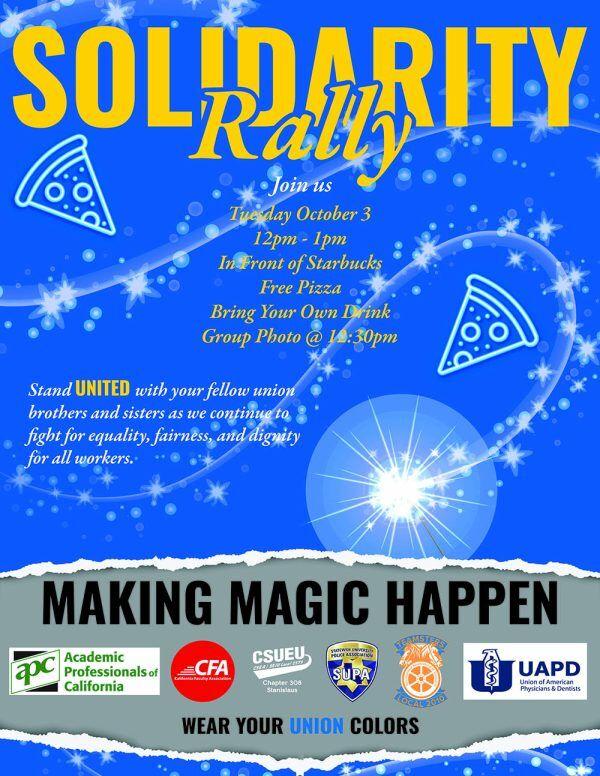The dedication ceremony of the newly installed Peace Pole on campus was led by President Ellen Junn, Dr. Kilolo Brodie, Chair of the President’s Commission on Diversity and Inclusion (PCID) and Dr. Arun Gandhi, grandson of Mahatma Mohandas Gandhi.
The ceremony took place Apr. 27, in the quad between Main dining and the Library. In her opening remarks, President Junn stated that the pole has 16 removable panels that say “may peace prevail on Earth.”
Each panel on the pole represents the dominant languages spoken by California State University, Stanislaus (Stan State), students and people in the Central Valley.
“These languages may change over time as the demographics of our student body and our region change,” President Junn explained. “It’s an evolving peace pole that is reflective of the diversity on our campus and Central Valley.”
During the ceremony, Dr. Brodie invited students who spoke more than one language to the microphone so that they had a chance to speak the phrase, “may peace prevail on Earth,” in their own language.
Noriel Mostajo (junior, Business Administration) said, “I thought the ceremony was awesome. I loved that we had students speak the phrase, ‘may peace prevail on earth,’ in their respective languages.”
The last student to approach the microphone was Rachel Hess (senior, History). Hess explained that her other language is sign language because she is hard of hearing, and proceeded to sign “may peace prevail on Earth.”
Members of Movimiento Estudiantil Chicanx de Aztlán (MEChA) and the Saudi Club expressed that the Peace Pole had grammatical errors on its Spanish and Arabic panels.
According to the clubs, the Spanish panel on the pole read, “que la paz prevalezca en le tierra,” instead of “que la paz prevalezca en la tierra.” And the Arabic panel read “أحمع“ instead of “ أجمع.”
Neisha Rhodes, Director for Presidential Initiatives, confirmed on Apr. 27 the misspellings of the two panels and stated that the new corrected panels would be installed as soon as possible.
Furthermore, President Junn went on to say that the Peace Pole was designed by the PCID, and thanked Dr. Dean De Cocker, Chair of the Art Department, for his collaboration in the creation of the Peace Pole.
Before the ceremony, Dr. Gandhi expressed to The Signal that the pole is a first step in the right direction.
“It’s a wonderful first step. Just planting a peace pole is not going to bring peace; it’s a first step,” Dr. Gandhi emphasized.
Dr. Gandhi went on to point out that the pole itself doesn’t solve anything, “we have to learn about peace; we have to learn about peace [and] what peace [means], and then work toward creating that peace within the campus and in our own [lives].”
He later stressed this point after President Junn unveiled the Peace Pole and Dr. Gandhi approached the podium.
Moreover, Dr. Gandhi expressed that he always takes the opportunity to travel anywhere he is invited to spread this message of peace.
“I always go places wherever I am invited to plant seeds of peace,” Dr. Gandhi said. “I call myself a peace farmer. I take every opportunity to plant those seeds and hope that someday they will germinate and have a world full of peace makers.”
Alexander Aust, Coordinator for Resident Engagement & Community for Housing and Residential Life, attended the dedication ceremony and feels that the Peace Pole serves as a reminder to the campus community of its promise to celebrate diversity.
“I think it speaks to the diversity that we strive [to] have and are working towards as a campus. It celebrates that the fact that we are trying to be welcoming,” Aust said. “I think he brings a big legacy to campus considering he is the grandson of Gandhi. I think he spoke to the message of the pole and the message we are trying to bring to campus.”
Michelle Akanji (senior, Kinesiology) says that she only recently knew what a Peace Pole was through the dedication ceremony.
“I’ve never heard about a ‘peace pole’ before until I received the campus email explaining about it,” Akanji said. “Dr. Gandhi is a great representation of peace and hope, and I am very pleased he was involved in the ceremony.”
During the keynote address, followed after the dedication ceremony, President Junn expressed that Peace Pole “[is] a perfect fit for our university’s renewed commitment on becoming a beacon for all who aspire to clear obstacles [by] solving disagreements through constructive, respectful and peaceful dialogue.”
Dr. Gandhi proceeded the keynote address by recounting his experiences as a light-skinned person living in South Africa during the apartheid regime.
“I was beaten up by whites because I was too black and beaten up by black because I was too white,” Dr. Gandhi recalled.
He proceeded to speak about his time with his grandfather, Mahatma Mohandas Gandhi, and the lessons he was taught.
“I intend to show you his human side,” referring to authors who have written about Mahatma Gandhi as a saint. “He was like all of us, a very ordinary person. He was a human being with the same frailties and shortcomings that all of us have as we grow.”
In his speech, Dr. Gandhi stated, “If we can make an effort to control 50% of our anger, we can make a tremendous difference in the level of violence we experience in our lives.”
“If we can learn to reduce the abuse of anger and learn to channel that energy intelligently and constructively, we will make a tremendous difference in the level of violence we experience.” Dr. Gandhi stressed.
Adam Webber (junior, Political Science) said that although the university has a good first step toward creating a safe space for students, it still has work to do in order for it to becomes an inclusive campus.
Webber expressed this sentiment in a question he posed after Dr. Gandhi’s keynote address.
Webber asked Dr. Gandhi, “As a person with disabilities I often feel forgotten about here on this campus by the way things are designed.” Webber is a student who uses a wheelchair.
“Other disabled students–disabled, a label that society puts on us– often feel forgotten here on the university. How can we all try to remember groups that are not remembered?”
Dr. Gandhi replied to Webber saying that “we need to take into account the different needs of society as a whole and that can happen when we have better relationships [where] we are able to reach out to the whole community to see what their needs are.”
In a follow up interview, Webber expressed that although he has often felt forgotten by the campus administration, when making policies in the past, he feels hopeful that President Junn will work toward creating a more accessible University. Webber sees Dr. Gandhi’s presence as a positive movement toward a more inclusive campus.
However, though many felt optimistic about the significance and the symbolism the Peace Pole dedication brought to the campus, there are others who resent Dr. Gandhi’s participation.
When Rajvir Kaur Chohan, student of Master’s in Social Work, learned that Dr. Gandhi was coming to Stan State to present the Peace Pole she became upset.
“I personally feel very upset and hurt by Dr. Gandhi’s presentation of the Peace Pole for many reasons. I am upset because his grandfather, Mahatma Gandhi, does not represent peace nor commitment to diversity,” Chohan said. “Central California is home to almost 50 percent of the Sikh American population and the Peace Pole was presented by the grandson of someone who referred to Sikhs as Hindus.”
Chohan further expressed her frustration by saying that “Mahatma Gandhi mocked the teachings of Sikhism. His actions lead to the Sikh genocide, which is still not recognized by the government today.”
She cautioned that “there is danger in a single narrative, which is why I hope to learn more and challenge this false narrative of Gandhi. I hope Stan State can do the same.”
Jennifer Morales, student of Master’s in Social Work, questioned Dr. Gandhi’s price for his attendance.
“When I became aware Dr. Gandhi would be speaking at CSU Stanislaus, my first thought was, how much did it cost to bring Dr. Gandhi to speak at this event?” Morales said.
Morales added, “I do not believe Gandhi should be viewed as someone who can bring peace everywhere, nor do I agree with using his image to promote peace in the Central Valley.”
She also believes that it would have been beneficial to the Stan State community to hear from people within the Central Valley who work toward creating peace locally instead of Dr. Gandhi.
“How can we promote peace with individuals who do not understand the complex issues within the community that impact the presence of peace?” Morales stated.



















